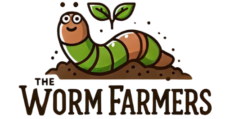So, you’re curious about worm composting but have questions—maybe a lot of them. Don’t worry; we’ve got you covered! Below are the most frequently asked questions about worm composting, answered with just the right mix of knowledge and humor to keep things interesting.
General Questions About Worm Composting
1. What is worm composting?
Worm composting, or vermicomposting, is a process where worms eat your food scraps and turn them into nutrient-rich compost. It’s recycling at its wriggliest.
2. Why should I start worm composting?
Because it’s eco-friendly, reduces waste, saves you money on fertilizers, and gives you an excuse to say, “I’m feeding my worms” at dinner parties.

Worm Bin Setup
3. What kind of worms should I use?
Red wigglers (Eisenia fetida) are the MVPs of composting worms. They thrive in organic waste and are easy to care for. Check out our guide to Best Worms for Composting.
4. What type of bin do I need?
You can use a store-bought worm bin or make your own. Just make sure it’s opaque, well-ventilated, and has drainage holes. Read Best Worm Composting Bins for Beginners or How to Build a DIY Worm Bin for tips.
5. Can I keep my worm bin indoors?
Absolutely! A properly maintained worm bin doesn’t smell, making it perfect for kitchens, basements, or closets.
Feeding Your Worms
6. What can I feed my worms?
Worms love:
- Fruit and veggie scraps
- Coffee grounds
- Crushed eggshells

Avoid:
- Citrus
- Meat and dairy
- Oily foods
Check out What You Can and Can’t Compost in a Worm Bin for a complete list.
7. How often should I feed my worms?
Once or twice a week is plenty. Start small and adjust based on how quickly they eat.
Troubleshooting
8. My bin smells bad. What do I do?
A healthy worm bin should smell earthy. If it stinks:
- Reduce feeding.
- Fluff the bedding for better airflow.
- Remove any rotting food.
Need more help? Read How to Fix a Stinky Worm Bin.
9. Why are my worms trying to escape?
Worms will flee if conditions aren’t right. Check:
- Moisture levels (too wet or too dry).
- Bedding temperature (55–77°F is ideal).
- Food (avoid salty or acidic scraps).
Worm Composting Maintenance
10. Do I need to stir the bin?
Not exactly. Worms do the mixing, but gently fluffing the bedding once in a while improves aeration.
11. How do I harvest the compost?
Push everything to one side, add fresh bedding and food to the other, and wait for the worms to migrate. Then collect the finished compost. Learn more in How to Harvest Worm Castings Like a Pro.
Advanced Questions
12. Can I use worm compost for all plants?
Yes, but avoid using raw worm castings on seedlings—they’re too rich. Dilute with soil or make worm tea. Read 5 Easy Ways to Use Vermicompost in Your Garden.
13. What happens in winter?
Worms slow down in colder weather. Keep the bin indoors or insulate outdoor bins to protect them.

Quick Reference: Do’s and Don’ts of Worm Composting
Do:
- Keep the bin moist and cool.
- Chop food scraps into small pieces.
- Cover food with bedding to prevent pests.
Don’t:
- Overfeed your worms.
- Let the bin dry out.
- Add salty or oily foods.
More Useful Worm Composting Links
- Learn more about how to start worm composting.
- Discover The Environmental Benefits of Worm Composting.
- Troubleshooting? Read Common Worm Bin Problems.
Final Thoughts
Worm composting might seem intimidating at first, but with these FAQs, you’re well on your way to becoming a vermicomposting pro. Got more questions? Drop them in the comments, and we’ll get you the answers you need—no question is too small or too weird (trust us).
Happy composting!





